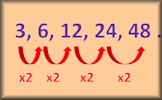Here are some specific activities, investigations or visual aids we have picked out. Click anywhere in the grey area to access the resource.
Here is an exam-style questions on this statement:
Here is an Advanced Starter on this statement:
Click on a topic below for suggested lesson Starters, resources and activities from Transum.
Furthermore
A geometric sequence is a sequence of numbers where each term after the first is found by multiplying the previous term by a fixed, non-zero number called the common ratio. If the common ratio is greater than -1 and less than 1, the sequence is said to be convergent. The sum of an infinite convergent geometric sequence can be found using a specific formula. This sum is finite and is often referred to as the limit of the sequence as the number of terms approaches infinity.
The formula to find the sum \( S \) of an infinite convergent geometric sequence with a first term \( a \) and a common ratio \( r \) (where \( |r| < 1 \)) is given by:
$$ S = \frac{a}{1 - r} $$
For example, consider an infinite geometric sequence with a first term \( a = 3 \) and a common ratio \( r = 0.5 \).
Using the formula, the sum of this sequence is:
Thus, the sum of the infinite convergent geometric sequence with terms starting at 3 and halving each time is 6.
This video on Geometric Sequences is from Revision Village and is aimed at students taking the IB Maths Standard level course.
How do you teach this topic? Do you have any tips or suggestions for other teachers? It is always useful to receive feedback and helps make these free resources even more useful for Maths teachers anywhere in the world. Click here to enter your comments.


